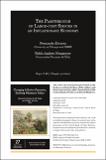Mostrar el registro sencillo del ítem
The passthrough of large-cost shocks in an inflationary economy
| dc.contributor.author | Álvarez, Fernando | |
| dc.contributor.author | Neumeyer, Pablo Andrés | |
| dc.date.accessioned | 2020-09-29T16:44:58Z | |
| dc.date.available | 2020-09-29T16:44:58Z | |
| dc.date.issued | 2020 | |
| dc.identifier.issn | 978-956-7421-67-1 | |
| dc.identifier.issn | 978-956-7421-68-8 (pdf) | |
| dc.identifier.uri | https://hdl.handle.net/20.500.12580/4879 | |
| dc.description | This paper surveys and modestly extends the theory of menu-cost models of the behavior of the aggregate price level after large-cost shocks. It does so in the context of an economy with a high underlying rate of inflation. It concentrates on the effect of large permanent and unexpected increases in the nominal price of inputs on the price level at different horizons. We use a simple theoretical model where increases in nominal cost will increase aggregate prices one for one in the long run. We study how the nominal rigidities implied by a menu cost distribute the increases in the price level between the impact effect immediately after the cost shock and the subsequent price adjustment until the price catches up with its long-run increase. In other words, we study the passthrough of large-cost shocks at different horizons. We pay particular attention to the role of the underlying inflation rate as well as to the role of the size of the cost shock, since both elements are important to determine the dynamics of aggregate prices. | es_ES |
| dc.description.abstract | This paper surveys and modestly extends the theory of menu-cost models of the behavior of the aggregate price level after large-cost shocks. It does so in the context of an economy with a high underlying rate of inflation. It concentrates on the effect of large permanent and unexpected increases in the nominal price of inputs on the price level at different horizons. We use a simple theoretical model where increases in nominal cost will increase aggregate prices one for one in the long run. We study how the nominal rigidities implied by a menu cost distribute the increases in the price level between the impact effect immediately after the cost shock and the subsequent price adjustment until the price catches up with its long-run increase. In other words, we study the passthrough of large-cost shocks at different horizons. We pay particular attention to the role of the underlying inflation rate as well as to the role of the size of the cost shock, since both elements are important to determine the dynamics of aggregate prices. | es_ES |
| dc.format | ||
| dc.format.extent | Sección o Parte de un Documento | |
| dc.format.medium | p. 07-48 | |
| dc.language.iso | en | es_ES |
| dc.publisher | Banco Central de Chile | es_ES |
| dc.relation.ispartof | Series on Central Banking Analysis and Economic Policies no. 27 | |
| dc.relation.ispartof | Serie Banca Central, análisis y políticas económicas, no. 27 | |
| dc.rights | Attribution-NonCommercial-NoDerivs 3.0 Chile | * |
| dc.rights.uri | http://creativecommons.org/licenses/by-nc-nd/3.0/cl/ | * |
| dc.subject | INFLACIÓN | es_ES |
| dc.title | The passthrough of large-cost shocks in an inflationary economy | es_ES |
| dc.type.doc | Artículo |


